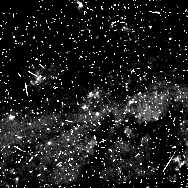Classifying variable phenomena on HST images
It's not always easy to discern the nature of the variations you see
between blinked image. Sometimes the variations are not celestial at
all; they can be caused by electronic problems or stray particles
striking the detector. Using more than 2 epochs sometimes helps to
distinguish between real variations and stray events.
The zoomed region of WF4 we've been viewing has no known Cepheids.
Let's blink a series of images taken at 6 epochs to try to discern the
nature of some of the variations. The images below were taken on April
23, May 4, May 6, May 26, May 31 and June 17 of 1994.

What are some of the possible sources of variation?
- Slight shifting of image. The images seem to shift
slightly from epoch to epoch. This is simply a measure of how
accurately the telescope can be pointed. The pointing may vary by a
fraction of a pixel, which causes a noticeable shift on the zoomed
scale of these images.
- Variable Stars. Most of the small roundish objects in the
images are stars. Variable stars are fairly common. Some of the stars
in the above images appear to vary. Always remember that Cepheids are
a special variety of variable star; not all variable stars are
Cepheids. Some of the variable stars may in fact be Cepheids, but the
data is not sufficient to discern the Cepheid characteristics.
Another point to remember is that it is possible for a constant star
to vary a bit in appearance in the sequence of blinked images, owing
to slight differences in telescope pointing, exposure conditions, and
the images processing used to create these images.
- Cosmic rays. Although space is a vacuum by Earth
standards, there are still many high-energy particles called cosmic
rays whizzing through the universe. Cosmic rays regularly strike
astronomical detectors and leave streaks or blotches in the images.
The images you are viewing have been cleaned to remove most of the
cosmic rays, but the cleaning routines are far from perfect. Blinking
"before" and "after" images from May 4, 1994 will demonstrate the
difficulty.
- Frame 1 is a single 30 minute exposure of WF4 before cosmic rays
have been removed with sophisticated computer programs.
- In Frame 2, two consecutive 30-minute exposures were compared to
remove cosmic rays. A constant background level has also been
subtracted. The contrast has been adjusted to most nearly agree with
Frame 1. Most streaks are oblique cosmic ray hits. A head-on strike
creates a more stellar-like image.

You can see that cosmic rays are a major issue in long exposures. No
computer program can perfectly remove all the cosmic rays. How can you
tell the difference between a head-on cosmic ray hit and a variable
star? Cosmic ray hits are random. It is extremely unlikely that a
cosmic ray will hit the exact same location on the chip in two or more
of the six epochs you will be blinking. A cosmic ray will appear
as a blip in only one image. A variable star will be visible in the
same location in at least two of the images.
- Nebulosity. The gas and dust in the disk of M100 appears as
nebulosity in the zoomed images. Owing to changes in exposure
conditions, it is impossible to match the contrast levels across all 6
epochs. Apparent changes in nebulosity intensity are almost always a
result of image processing.
- Asteroids. It is possible that moving blips may be
asteroids. Asteroid orbits may be inclined as much as 30 degrees to
the ecliptic. M100 is located less than 20 degrees north of the
ecliptic. (See the Messier catalog for
coordinates.)
- Bad pixels. Some pixels in the detector have electronic
problems, and may be unusually bright. The smoothing routine used on
the images can make these "bad pixels" appear starlike. Some bad
pixels are permanently bad, some are intermittent.
The professional astronomers did not blink images to find Cepheid
variables. They used sophisticated computer programs to hunt for
them. There was no need to remove cosmic rays for the professional
hunt; a cosmic ray or bad pixel does not behave like a Cepheid
variable. The computer programs could distinguish subtleties the eye
cannot. Checking results visually is still a good idea -- one wants to
be sure the program is behaving!
On to Hunting Cepheids
Back to Looking for variable phenomena
Back to the table of contents


